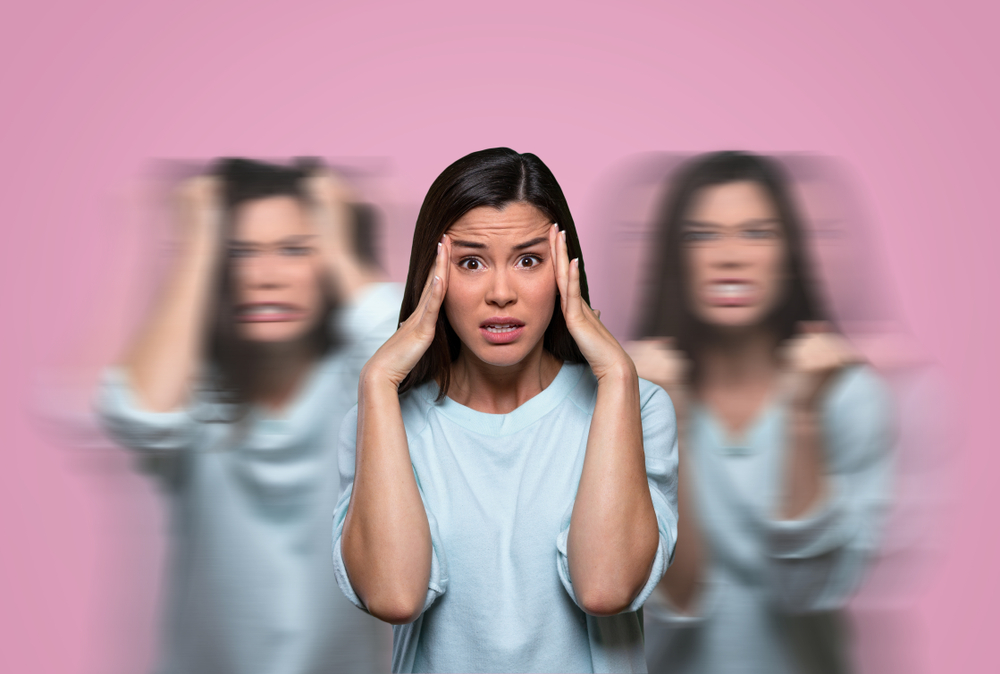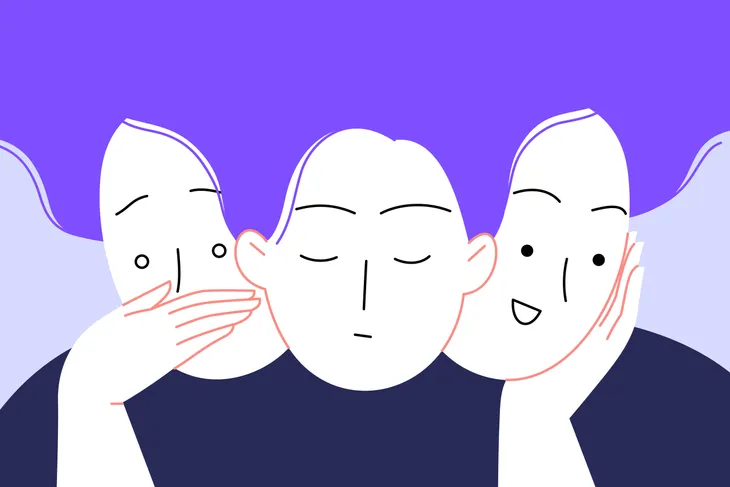- Mental health disorders are common, with 1 in 8 people living with one or more diagnoses.
- There are a wide variety of disorders, but major depressive disorder, bipolar disorder, and anxiety disorders are the most common.
- There are a number of ways to treat and manage mental illness, but most require a multi-faceted approach and the support of a professional.
Mental health refers to a person’s psychological, emotional, and social well-being, according to the Centers for Disease Control and Prevention (CDC) definition. It affects our interpersonal relationships, and the ability to deal with stress, make healthy decisions, and deal with the day-to-day. To oversimplify, mental illness occurs when the brain isn’t working properly.
Read on to learn more about mental health disorders, including their prevalence, risk factors, and common types.
Mental Disorders vs. Mental Health
It’s important to clarify that poor mental health and mental illness are not the same. Mental health disorders are “characterized by a clinically significant disturbance in an individual’s cognition, emotional regulation, or behaviour,” according to the World Health Organization (WHO). They negatively affect a person’s daily functioning and cause significant distress.
Poor mental health, on the other hand, may just refer to a period of time where a person is struggling with how they think, feel or react to stresses in their life. A person who has poor mental health is not necessarily mentally ill, in the same way, that a person who has an injury that’s healing doesn’t necessarily have a chronic illness.
Prevalence of Mental Health Diagnoses
The prevalence of mental health disorders is staggering, both in North America and around the world. According to the National Alliance on Mental Illness, 1 in 5 American adults and 1 in 6 American youth (ages 6-17) experience some type of mental illness in a given year. As of 2019, 1 in 8 people or 970 million people around the world live with a mental health disorder.
According to the American Psychiatric Association, 50 percent of mental illnesses begin by the age of 14, and 75-percent begin by the age of 24. The age that the diagnosis occurs, however, varies. Some mental disorders, in particular bipolar, post-traumatic stress, and borderline personality disorders, are often mis- or undiagnosed for years.
What Causes Mental Illness
Professionals believe that mental illness is the result of the intersection of physical, environmental, and social factors. There are a number of factors that may contribute to the risk of mental illness including:
- Genetics
- Addiction
- Daily habits
- Trauma
- Chronic stress
- Other chronic medical conditions
- Feelings of loneliness and isolation
Major Depressive Disorder
More commonly known as clinical depression, major depressive disorder (MDD) is one of the most common mental health disorders. This mood disorder affects a person’s ability to perform day-to-day activities and can, in some cases, make a person feel their life isn’t worth living. It tends to affect women more than men.
Some people may only experience depression once in their life while others may have multiple episodes or experience it chronically. Globally, around 5-percent of people suffer from the disorder.
Common symptoms include:
- Feelings of sadness or hopelessness
- Loss of interest in normal, enjoyable activities
- Changes in sleep, either an increase or insomnia
- Tiredness and lack of motivation
- Changes in appetite and weight
- Anxiety and agitation
- Recurrent thoughts about self-harm
Generalized Anxiety Disorder
Generalized anxiety disorder (GAD) affects 3.1-percent of Americans, with a disproportionate effect on women. Children, teens, and adults can all suffer from this mental illness. This disorder goes beyond normal nerves or worries, causing a person to overthink things and feel extreme, persistent worry that they struggle to control.
Other symptoms include:
- Unwarranted or disproportionate worry
- Difficulty handling uncertainty
- Indecisiveness
- Inability to focus
- Feelings of restlessness, twitchiness
- Nervousness
- Nausea, diarrhea, or other GI issues
- Sweating
- Fatigue
- Insomnia
Unfortunately, GAD tends to occur alongside other mental disorders such as depression, phobias, post-traumatic stress disorder (PTSD), and obsessive-compulsive disorder (OCD).
Bipolar Disorder
Bipolar disorder affects approximately 2.6-percent of the American population, with 83-percent of diagnosed cases classified as severe, according to the National Alliance on Mental Illness.
It’s characterized by feelings of extreme highs and lows, known as mania and depression, which affect a person’s mood, ability to think, relationships, and energy. A person may experience delusions and hallucinations during both manic and depressive episodes.
Subtypes of Bipolar Disorder
There are four types of bipolar disorder, including:
- Bipolar I – Diagnosed after at least one episode of mania that lasts at least 7-days or requires hospitalization. Most people with this type also experience depressive episodes, but it’s not necessary for a diagnosis. This is the most common type of bipolar.
- Bipolar II – Diagnosed when a person has depressive and hypomanic episodes, but not “full” manic episodes.
- Cyclothymia – Diagnosed when a person experiences hypomanic and mild depressive states for at least 2-years. They may experience periods of symptom relief and feel “normal”, but for no longer than 8-weeks at a time.
- Bipolar Unspecified – Diagnosed when a person does not meet the requirements for the above three types but has clinically significant abnormal mood elevation.
Social Anxiety Disorder
Social anxiety disorder, previously called social phobia, is marked by an extreme and constant fear of at least one social or performance situation during which a person fears embarrassing or humiliating themselves. It can be mild, moderate, or severe, and often causes people who suffer from it to avoid social situations and gatherings altogether.
Social anxiety disorder affects 15 million adults or 7.1-percent of the American population, according to the National Institute of Mental Health.
Post-Traumatic Stress Disorder
Post-traumatic stress disorder (PTSD) is a common mental illness initially diagnosed in war veterans in the 1980s. Before that, people knew it as “shell shock” or “war neurosis.” People can develop PTSD after experiencing or witnessing a traumatic event, though only about 20-percent of people who experience a trauma will get PTSD. Common symptoms include:
- Flashbacks
- Irritability or angry outbursts
- Hypervigilance
- Isolation
- Difficulty sleeping
- Being easily startled
According to the U.S. Department of Veterans Affairs, an estimated 6-percent of adults in the U.S. will experience PTSD during their lives, while about 12 million have it in a given year. Women are about two times more likely to experience the disorder compared to men.
Obsessive Compulsive Disorder
According to the Anxiety & Depression Association of America, obsessive-compulsive disorder (OCD) affects about 2-percent of Americans, which is about 2.2. million adults. The disorder is diagnosed when a person experiences obsessions, compulsions, or (more commonly) both.
Obsessions are unwanted, unreasonable, and repeated intrusive thoughts or urges that originate in a person’s mind. They are uncontrollable, time-consuming, and often accompanied by intense mental discomfort. The International OCD Foundation classifies common obsessions for those with OCD as those related to:
- Contamination
- Religion or morality
- Identity
- Order or perfectionism
- Violence or agression
However, more broadly they can be grouped into contamination, doubt and checking, ordering and arranging, and unacceptable or taboo thoughts. Compulsions, on the other hand, are repetitive thoughts or behaviors that a person with OCD uses to cope with their obsessions. A compulsion is labeled depending on the function, context, and feelings associated with it. Those who experience them would most often rather not have to do them but feel deeply driven to perform them nonetheless.
Borderline Personality Disorder
Borderline personality disorder (BPD) is primarily characterized by a person’s inability to regulate their emotions, resulting in extreme mood swings, a lack of impulse control, and poor self-esteem. All of this can contribute to repeated unstable relationships with friends, family, and others, swinging from intense closeness to intense dislike quickly and without obvious cause. An estimated 1.4-percent of American adults experience the disorder, and a surprising 75-percent of those are women.
Other symptoms of BPD include:
- Problems controlling anger
- Distorted view of self
- Tendency to avoid abandonment, both real and perceived
- Dissociation
- Feelings of emptiness
- Self-harm, or thoughts or threats of self-harm
- The occurrence of another mental illness, such as PTSD
Periods of time where a person experiences symptoms are called episodes, and the frequency, severity, and length of episodes vary depending on the person’s illness and how it’s being managed.
When It’s Time to Get Help
Arguably, it’s never too soon or too late to ask for help. If you’re struggling with your mental health, whether you have a diagnosed mental illness or not, reach out to your doctor or a licensed therapist.
For all of these mental health disorders, there is treatment. Though in some cases, there is no “cure”, treatment can help manage symptoms and reduce the impact of the disorder on a person’s day-to-day. Common treatment options include:
- Medication
- Therapy
- Reducing or omitting substance use
- Lifestyle changes
- Relation techniques, including meditation
Depending on a person’s circumstances, social services (such as education or retraining programs), affordable safe housing, and financial assistance can also be critical to a person’s recovery and treatment plan.















